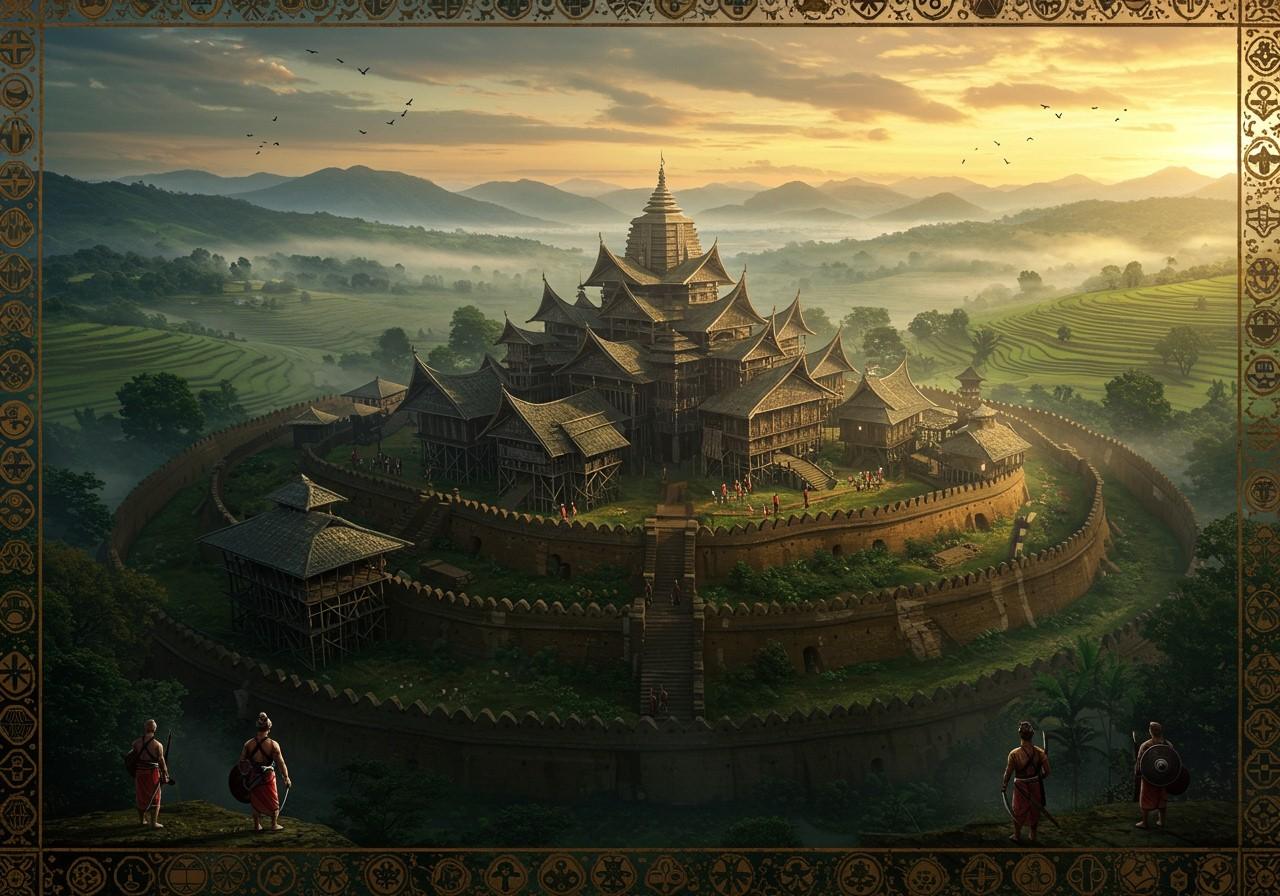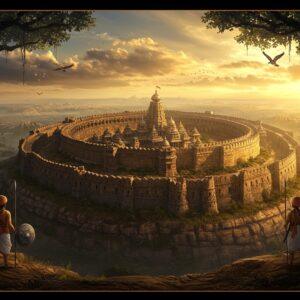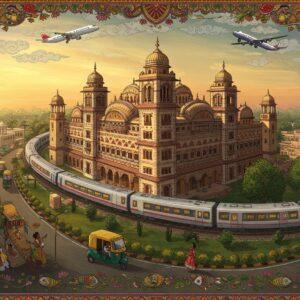
The Kachari Kingdom, a prominent power in Assam from the 13th to the 19th century, left an enduring legacy on Northeast India’s history and culture. Their journey, marked by shifts in capitals, reflects not just political changes but also the evolution of their society, traditions, and interactions with neighboring kingdoms. Let’s delve into the story of these capitals—Dimapur, Maibong, and Khaspur—and uncover the rich tapestry of the Kachari Kingdom.
Dimapur: The Genesis of a Kingdom
Our journey begins in Dimapur, the first capital of the Kachari Kingdom, established around the 13th century. Situated in present-day Nagaland, Dimapur’s strategic location along vital trade routes fueled its growth and importance. The remnants of the Kachari Rajbari, a testament to the dynasty’s architectural prowess, still stand as a proud reminder of their reign. Dimapur wasn’t merely a political center; it thrived as a melting pot of cultures, facilitating exchanges and influencing Kachari civilization in profound ways. The presence of monoliths, temples, and other archaeological findings whisper tales of this vibrant past, inviting us to connect with the region’s rich heritage.
To bring a touch of spirituality and tradition to your home, explore our exquisite collection of decorative items. From intricately designed diyas to auspicious wall hangings, find the perfect pieces to enhance your puja space and create a serene ambiance.
Maibong: A Capital Fortified by Nature
Around the 16th century, amid growing conflicts with the Ahom kingdom, the Kacharis shifted their capital to Maibong. Nestled in the picturesque hills of Assam, Maibong provided natural defenses and abundant resources. This transition marked a new chapter in the kingdom’s history, where they continued to flourish amidst challenges. The architecture of Maibong beautifully blends indigenous styles with external influences, showcasing the unique craftsmanship of the era. The ancient stone house, a notable structure from this period, stands as a testament to their ingenuity. The Mahur River, flowing gracefully nearby, not only enhanced the city’s beauty but also served as a vital lifeline.
Enhance your puja experience with high-quality flammables from Poojn.in. We offer a wide range of incense sticks, dhoop, and diyas to create a sacred atmosphere during your prayers.
Khaspur: The Final Chapter
The final chapter of the Kachari Kingdom unfolds in Khaspur, near present-day Silchar. With the decline of Koch rule in the 18th century, Khaspur became the kingdom’s last capital. The city flourished as a hub of art and culture, even as it navigated complex political dynamics and pressures from neighboring kingdoms. The remnants of the royal palace in Khaspur and the various temples scattered across the city bear witness to the grandeur and spiritual life of that era. While the kingdom eventually became part of colonial Assam in the 19th century, Khaspur’s contributions to Assam’s heritage continue to inspire awe and appreciation.
Discover the perfect attire for your spiritual practices with our collection of holy clothing at Poojn.in. We offer a wide variety of traditional garments for men and women, ensuring comfort and reverence during your rituals.
The Enduring Legacy of the Kachari Kingdom
The capitals of the Kachari Kingdom—Dimapur, Maibong, and Khaspur—represent much more than mere political centers. They were crucibles of culture, innovation, and resilience. The Kachari rulers left their mark on art, architecture, religion, and the very fabric of society. Their legacy lives on through the festivals, rituals, and traditions of Assam, a testament to their enduring influence. Archaeological findings in these cities continue to shed light on the region’s rich history, helping us piece together the vibrant tapestry of Northeast India’s past.
Immerse yourself in the spiritual wisdom of the ages with our collection of holy books. Find sacred texts from various traditions to deepen your understanding and connect with the divine.
Poojn.in: Honouring Tradition in South Dinajpur
Poojn.in proudly serves South Dinajpur, including areas like Boardangi and East Belbari, once part of the Kachari Kingdom’s realm. We offer a wide selection of puja items and ritual materials, helping residents connect with their rich heritage. From traditional items used in local temple rituals to pure copper and brass pieces reflecting historical craftsmanship, we aim to preserve the cultural legacy of the region. Our services include free delivery across South Dinajpur, expert guidance on ritual items via phone (03369029784), WhatsApp support (9476142738) for product inquiries, and detailed product information to ensure you find exactly what you need.
Experience the finest quality puja essentials with our specially curated collection of Kabab Chini and Char Magaz. Sourced with utmost care, these ingredients are essential for various rituals and ceremonies.
Conclusion: A Tapestry of History and Culture
The Kachari Kingdom’s journey, as seen through its capitals, is a powerful narrative of cultural evolution and resilience. From Dimapur’s bustling trade routes to Maibong’s serene hills and Khaspur’s artistic heart, each capital contributed uniquely to the region’s identity. Their story is an inspiration, a reminder of the enduring power of tradition, adaptation, and the indelible mark left by those who came before us.
FAQs: Unraveling the Kachari Kingdom
What distinguished the Kachari Kingdom? The Kachari Kingdom stood out for its rich cultural blend of animism and Hinduism, its unique architectural style, and its complex political interactions within the region. Their three ruling clans – Bodosa, Thaosengsa, and Hasyungsa – and a democratic royal assembly called Mel, highlight their unique societal structure.
What made Dimapur such a pivotal location? Dimapur flourished due to its strategic position on key trade routes. This fostered economic growth and cultural exchange, significantly shaping the kingdom’s early development and its connection to broader networks. The 10th century onwards marked their settlement and territorial expansion, utilizing the Brahmaputra River for vital resources.
Why did the Kachari Kingdom relocate its capital multiple times? The Kachari Kingdom shifted capitals primarily due to external pressures. Conflicts with the Ahoms in the 16th century led to the move from Dimapur to Maibong. The shift to Khaspur in the 18th century followed the decline of Koch rule and offered new opportunities for expansion. These relocations demonstrate the kingdom’s adaptability and strategic responses to a changing geopolitical landscape.
What key events defined the later period of the Kachari Kingdom? The early 19th century brought Burmese occupation, followed by a brief restoration under British rule after the 1826 Treaty of Yandabo. The death of the last king in 1830 led to British annexation, marking the kingdom’s absorption into colonial Assam. This period highlights the kingdom’s struggle for autonomy amid powerful external forces.
Where can I learn more about the Kachari Kingdom’s history and architecture? You can explore more about the Chandela dynasty and their architectural marvels, including the Kandariya Mahadeva Temple, in our blog post here. For a deeper understanding of temple architecture, especially the Sas-Bahu temples, our guide here offers valuable insights. And to discover more about Badami’s temples and the Chalukya Dynasty’s architectural influence, visit our blogs here and here.


